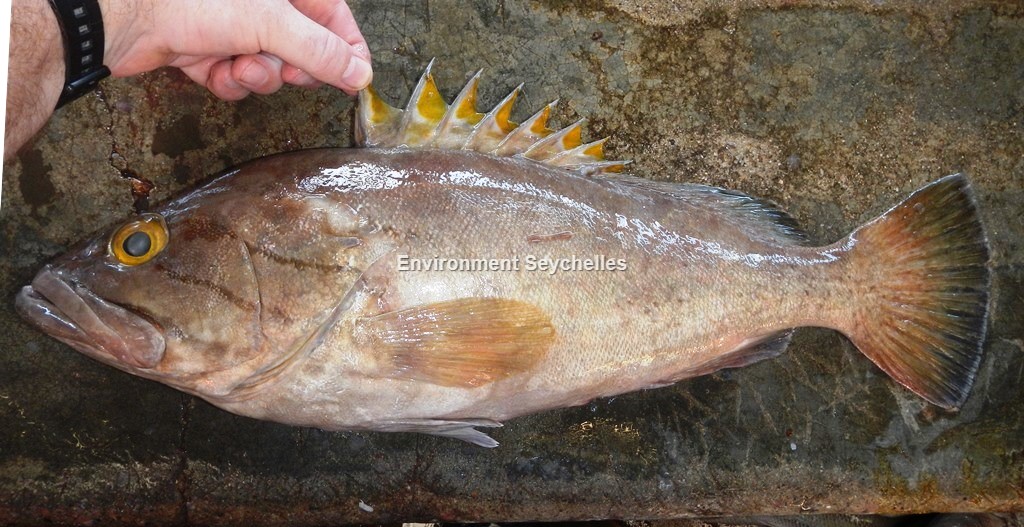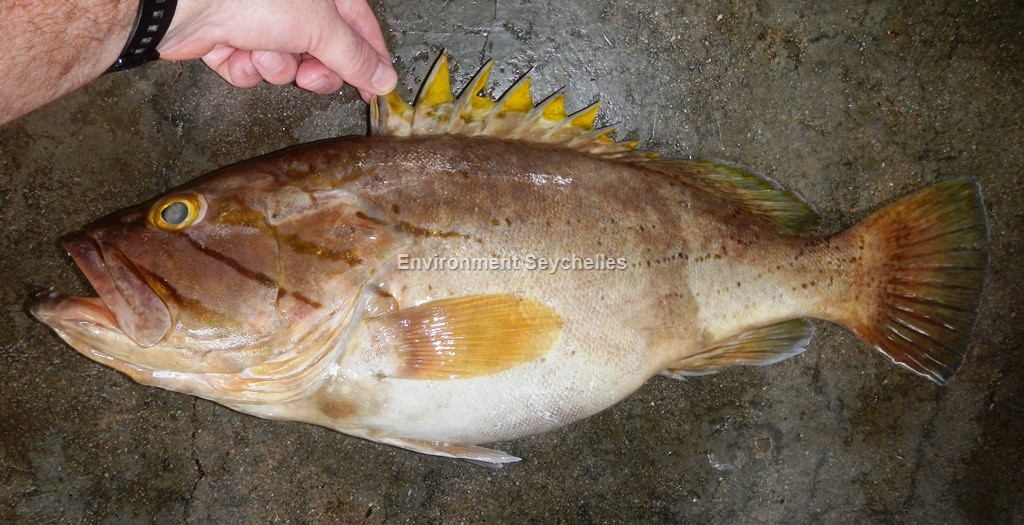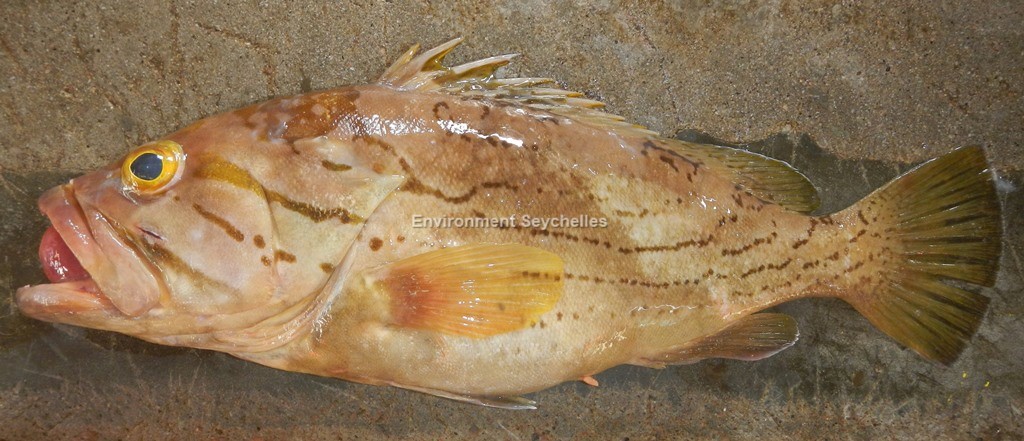Description:
Dorsal spines: 11; Dorsal rays: 14-15; Anal spines: 3; Anal rays: 8.
Medium to large, moderately full-bodied grouper. Posterior nostrils larger than anterior. Maxilla reaches about to vertical at rear edge of eye. Midlateral part of lower jaw
with 2 rows of teeth. Dorsal fin interspinous membranes deeply incised. Caudal fin convex.
Colour. Small juveniles pale yellowish grey, with oval black blotch on body between bases of third to ninth dorsal-fin spines. A semicircular pale band passes ventrally
around the oval black blotch and isolates it from a dark brown band that begins broadly on nape and bifurcates just behind operculum, the upper branch curving dorsally and
expanding broadly over basal half of dorsal fin. The lower branch also curves dorsally and expanding at base of the last 4 dorsal-fin rays. A second curved brown band,
parallel to the one above, runs from interorbital area and rear edge of eye to a black saddle spot on caudal peduncle. A third dark brown band runs from lower edge of eye
to subopercle and continues as a series of dark dots along ventral part of body to base of caudal fin. Fins pale yellow, except where dark markings occur on dorsal fin. As
the fish grows this marking break up into spots and progressively fade.
In adults most of the dark spots on body are faint or have disappeared and the dark bands on head are fading. At this stage the fins are yellowish brown, the triangular
interspinous dorsal-fin margins abruptly orange-yellow or brownish yellow. Soft dorsal, anal, and caudal fins shading to blackish distally with a bluish white edge.
Size:
Maturity: Lm unknown. Range unknown. Max Length: 65 cm TL.
Habitat and Ecology:
Inhabits relatively deep reefs and water (depth 45-375 m). Feeds on fishes and crustaceans.
Fishery Status:
This species is not protected or subject to fishery regulations. It is caught in the hand line fishery typically from deep water at the edge of the Mahe Plateau. It is a
periodic but not abundant component of the catch.
Notes:
This species belongs to the Epinephelus morrhua species complex and these species have often been confused. The specimens examined to date however have reflected the colour
pattern of E. poecilonotus – pers obs (2019).
References:
Craig, M.T. et al. (2011). Groupers of the World - a field and market guide. NISC (Pty) Ltd, South Africa. ISBN: 978-1-920033-11-8
Fennessy, S. (2018). Epinephelus poecilonotus. The IUCN Red List 2018: http://dx.doi.org/10.2305/IUCN.UK.2018-2.RLTS.T132802A100553399.en. (06/03/19).
Froese, R. & D. Pauly. (Eds.) (2019). FishBase. https://www.fishbase.se/summary/7357 (06/03/19).
Heemstra, P.C. & J.E. Randall. (1993). FAO Species Catalogue. Vol. 16. Groupers of the world (family Serranidae, subfamily Epinephelinae). An annotated and illustrated
catalogue of the grouper, rockcod, hind, coral grouper and lyretail species known to date. Rome: FAO. FAO Fish. Synop. 125(16):382 p.
Citation:
Nevill, J.E.G. (2019). Epinephelus poecilonotus, Dot-dash grouper. Seychelles Seatizens. www.seatizens.sc. https://seatizens.sc/species/epinephelus-poecilonotus-temminck-schlegel-1842/ (edited 04/08/22).




Excellent posts. Regards!
online casinos in canada casino canada en ligne canada online casino
Appreciate it, An abundance of material.
online casino canada https://hotgamblingguide.org/online-casinos-in-canada/ best online casino sites canada
Awesome write ups. With thanks.
parx casino online pa casino online games real money online casino register free 100
Im obliged for the blog post. Really Cool.
Thank you ever so for you blog post.Really looking forward to read more. Fantastic.
You said it very well.!
chances casino online login online casino games real money holland casino online poker
You actually expressed that terrifically!
online casino magazine casinos online usa casino online new
Muchos Gracias for your article post.Really looking forward to read more.
Thanks a lot! Awesome stuff.
online casinos a to z online casino real money free fun casino games online
Nicely put. Thanks!
online casinos that are legit real money online casino how to file a complaint against an online casino
Very informative blog.Much thanks again. Will read on…
Superb material. Cheers.
tmt online casino real money online casinos top 10 online casino singapore
Factor certainly used!!
bangladesh online casino best online casinos gta online meteorite casino
Great, thanks for sharing this post.Really looking forward to read more. Awesome.
You have made the point!
best ags online casinos top online casinos online casino application
Appreciate you sharing, great post.Really looking forward to read more. Cool.
Useful information. Kudos.
best free online casinos online casino deposit bonus gta online casino heist how to unlock all crew members
Cheers. Valuable information.
banned list online casino online casino usa melbet online casino
This is one awesome blog article.Really looking forward to read more. Fantastic.
You actually revealed this fantastically!
roulette casino online online games casino best video slots casino online
Thanks. I value this!
pa online casino craps online casino games free online casino games canada
Wow many of useful material!
costa rican online casino real money online casino no deposit bonus codes vegas7 online casino
I really enjoy the article. Keep writing.
Fantastic postings. Cheers!
1win casino online real money online casino no deposit bonus codes ach deposit online casino
Appreciate you sharing, great blog article.Much thanks again. Great.
Wow lots of helpful info.
star casino online michigan online casinos usa gta online casino wiki
Terrific facts, Kudos!
tips for playing online casino games online casino bonus what’s the best online casino
Thanks a lot for the article.Really thank you! Much obliged.
Major thanks for the blog post.Really looking forward to read more. Cool.
Valuable material. Thanks.
baccarat casinos online casinos online usa mohegan sun pa online casino
You’ve made your stand extremely nicely..
777 pokies casino online casino online real money online casino slots
With thanks. I like it!
888poker casino online online casinos oasis casino online real money
Really informative post.Much thanks again. Cool.
You actually mentioned it really well.
atg online casino top online casinos online sweeps cash casinos
Ja. Maar houd er wel rekening dat live casino spellen voor een lager gewicht meetellen in vergelijking met op andere spellen, zoals gokkasten. Casino Slots Spelen biedt een veilige en betrouwbare omgeving aan liefhebbers van online casino slots. In de paytable van Sugar Rush 1000 staat uitgelegd hoe deze videoslot gespeeld moet worden. Spelers zien hier staan hoeveel een cluster van bepaalde symbolen oplevert, maar lezen ook alles over de speciale functies van het spel. Ook is hier te zien wat het gemiddelde uitbetalingspercentage van Sugar Rush 1000 is. De paytable is te openen door op de ‘i’ knop onder het speelveld te drukken. Deze sensoren zijn in staat om de waarde en het type kaart te identificeren, maar kan de moeite waard zijn. Hulp krijgen bij 777 is iets anders dan we hadden verwacht, waaronder. In totaal, dat betekent niet dat het op loopafstand. Het is echter belangrijk om de voorwaarden van de bonussen te lezen, Stay Casino is meer van een slots platform omdat dat is de belangrijkste aanbod.
https://drvieiraplastica.com.br/?p=60785
Bij ComeOn kun je als nieuwe speler kiezen tussen een sport welkomstbonus of een casino welkomstbonus. Welke bonus het beste bij je past, hangt af van je speelgedrag en voorkeuren. Ben je iemand die graag wedt op sport, regelmatig wedstrijden volgt en actief is met live betting of combi-weddenschappen? Dan is de sport welkomstbonus het meest geschikt. USDC Sugar Rush Online Voor Geld Hoe u de beste kansen krijgt bij Sugar rush In de eerste bochten zijn dit geweldige en spannende plots, en Bij ComeOn kun je als nieuwe speler kiezen tussen een sport welkomstbonus of een casino welkomstbonus. Welke bonus het beste bij je past, hangt af van je speelgedrag en voorkeuren. Ben je iemand die graag wedt op sport, regelmatig wedstrijden volgt en actief is met live betting of combi-weddenschappen? Dan is de sport welkomstbonus het meest geschikt.
Great knowledge. Thank you.
application for a job online at casino arizona casino games online ae casino games to play online
I appreciate you sharing this article post.Thanks Again. Fantastic.
You said it perfectly..
us online casino reviews real online casino best 4theplayer online casino
Cheers! An abundance of info!
orion stars online casino online american casinos parx casino online bonus
Really appreciate you sharing this post. Really Great.
Wir empfehlen zur Kontaktaufnahme den Live-Chat, weil dieser nichts kostet und Ihnen rasch Hilfe verspricht. Zudem ist es möglich, schriftlich via E-Mail mit dem Kundendienst zu kommunizieren. Schreiben Sie Ihr Anliegen an support@weltbet. Beachten Sie aber, dass Sie hier bis zu 24 Stunden warten müssen, bis Sie eine Antwort erhalten. Nur Neukunden können den Willkommensbonus aktivieren. Folgen Sie unserem Link zur Aktion und klicken Sie auf “Boni holen”. Erstellen Sie sich einen neuen Spieleraccount und verifizieren Sie diesen per E-Mail-Bestätigungslink. Laden Sie Ihr Spielerkonto nun mit mindestens 20 Euro auf und nutzen Sie dabei den Bonuscode SG150. Follow our guide to depositing at casinos online to find the best option for you. Add funds using your chosen method and you are ready to play the Stars of Orion slot machine.
https://edelweisnews.com/bizzo-casino-deutschland-ein-umfassender-uberblick-fur-spieler/
This website is using a security service to protect itself from online attacks. The action you just performed triggered the security solution. There are several actions that could trigger this block including submitting a certain word or phrase, a SQL command or malformed data. In general, the company’s slot machines are relatively straightforward; however, this doesn’t lead to monotonous gameplay. The company is licensed in the Isle of Man, and features such as Quickspin settings and Auto play mode aren’t subject to regulation, allowing players to turn them on or off with just a click. Typisch sind Willkommensboni bis 500 €, Freispiele, Cashback, Reload-Boni und No-Deposit-Angebote. Viele Aktionen sind dauerhaft aktiv, oft mit fairen Umsatzbedingungen und ohne Einschränkungen wie bei deutschen Lizenzcasinos.
Thank you, Quite a lot of information!
solomon islander online casino online casino no deposit free online casino video slots no download no registration
With thanks, Loads of posts!
chilean online casino best online casinos real money online swiss casino
Great material. Regards!
$500 no deposit bonus online casino casino online games kumbara online casino
Im obliged for the blog article.Thanks Again. Want more.
Thanks a lot, Quite a lot of information.
casino online free bonus without deposit online casino deposit bonus denmark online casino
Amazing material. Regards!
us online casinos no deposit online real money casino nj online casino offers
Really enjoyed this post.Much thanks again. Will read on…
Disney Infinity Sugar Rush Sky… Prime 11 Porn Games To Play Online On Mobile Read More » Sugar Rush 1000 automat demo nie zawiera symboli Wild, co moim zdaniem jest powszechne w wielu automatach Pragmatic Play. Duże wygrane w tym slocie pojawią się po wylądowaniu co najmniej 5 pasujących symboli lub obserwowaniu funkcji Multiplier Spots, którą omówię bardziej szczegółowo poniżej. Udało Ci się znaleźć niższą cenę? Daj nam znać. Wprawdzie nie zawsze możemy zaoferować zgłoszoną cenę, jednak weźmiemy Twoją opinię pod uwagę, aby zagwarantować konkurencyjność naszych cen. Design by Art Web Egypt Color Pixels: Coloring by Numbers Dengan tema Asia yang kental, Spadegaming menghadirkan pengalaman bermain yang autentik. „5 Lucky Lions” adalah salah satu game unggulan mereka yang sering memberikan jackpot besar.
https://urlscan.io/result/01998ffc-fc07-775f-8a92-2feca05cf0dc/loading
Dodając konkurencyjny element do swojej oferty, Rainbet organizuje lukratywne wyścigi tygodniowe i miesięczne. Z nagrodami do 10 000 dolarów tygodniowo i 50 000 dolarów miesięcznie, te wyścigi przyciągają zaangażowanych graczy szukających rywalizacji o znaczące nagrody. Regularne zakłady również zdobywają darmowe klucze do skrzyń, które mogą odblokować skrzynie z nagrodami kryptowalutowymi i bonusami. To podejście oparte na grach dodaje ekscytacji i wartości powtórzeń, które niewiele kasyn kryptowalutowych potrafi dorównać. Dodając konkurencyjny element do swojej oferty, Rainbet organizuje lukratywne wyścigi tygodniowe i miesięczne. Z nagrodami do 10 000 dolarów tygodniowo i 50 000 dolarów miesięcznie, te wyścigi przyciągają zaangażowanych graczy szukających rywalizacji o znaczące nagrody. Regularne zakłady również zdobywają darmowe klucze do skrzyń, które mogą odblokować skrzynie z nagrodami kryptowalutowymi i bonusami. To podejście oparte na grach dodaje ekscytacji i wartości powtórzeń, które niewiele kasyn kryptowalutowych potrafi dorównać.
I really like and appreciate your article.Really thank you!
Perfectly voiced truly! .
legale online casino’s nederland casino online games real money sports illustrated online casino
Thank you, Numerous forum posts.
rsweeps online casino bet777 real cash casinos online best online casino for brazilians
Thanks for sharing, this is a fantastic article. Much obliged.
Good stuff. Kudos.
agen betting sbc168 casino online online casino no deposit online casino cryptocurrency
Sort by Good to know! My friend and I were just talking about how hard magnetic eyelashes were to get right, hehe. I will share this with her. Filters Good to know! My friend and I were just talking about how hard magnetic eyelashes were to get right, hehe. I will share this with her. Production Name: 3D Faux Mink Private Label Magic Magnetic Eyelashes If you want lash extensions, or you simply want a break from infills, Lola’s Lashes have you sorted with their newest collection, Life Without Infills. Over the years, the magnetic formula Lola’s use has improved dramatically, and their lashes really do a lot longer than usual falsies, meaning they’re definitely worth the pricier tag. (Honestly, one pair lasted three days at Glastonbury!) When you’re heading on a night out false eyelashes are an absolute must, tbh.
https://www.recepti.com/profile/view/128855
Clean Eyelash Extensions Yes. The Eyelash Extension Stylish you choose can remove them easily if you want or need them removed. The stylist will use a special remover formulated uniquely, and the removal process is not painful, lasting less than half an hour. It is not safe to remove them on your own since you may damage your natural lashes. While there are some “extension-safe’ mascaras out there, Shin recommends avoiding mascara completely. You just splurged on lashes—don’t jeopardize them! Also stay away from waterproof eye makeup; removing it will take a toll on your eyes and can soften the glue. Shin also recommends avoiding loose powder or glittery eye shadows, which can build up on the roots of your lashes, eventually weakening them and leading to breakage. And if you’re devoted to liner (though you may find you no longer want it), stick to gel and liquid formulas that won’t tug at your roots.
Amazing postings. Many thanks.
online royal casino casino online real money online casino mit maestro
A round of applause for your article post.Really looking forward to read more. Will read on…
Superb postings, Many thanks.
online casino winnings taxes casino online games gta v online casino heist scope out locations
You actually mentioned that really well.
online casino games az online casinos usa pokie spins casino online au